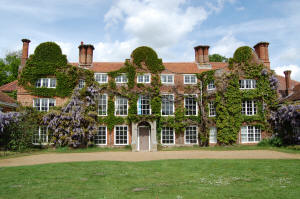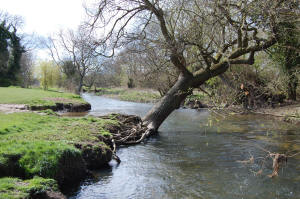Earlham
Earlham lies on the western side of
Norwich.
Earlham Hall, now part of the
University of
East Anglia, was built in 1642 by Robert Houghton. Later
it became the home of the Gurney family
who were influential Norwich Quakers. The philanthropist
Joseph John Gurney lived in the hall - as did his sister
Elizabeth Fry - the prison reformer. Many members of
the Gurney family are buried in the Gildencroft Quaker Cemetery
off St. Augustine's Street. Today it houses the UEA's Law School.

Earlham Hall Today
As a boy George Borrow used to fish the River Yare
near the bridge and on one occasion was caught by
Joseph John Gurney. However, Gurney then invited the boy
into the hall to see his books. In his autobiographical
novel Lavengro Borrow recalls the hall with great
precision :
|
|
'On the right side is a green level, a smiling meadow,
grass of the richest decks the side of the slope; mighty
trees also adorn it, giant elms, the nearest of which,
when the sun is nigh its meridian, fling a broad shadow
upon the face of the ancient brick of an old English
Hall. It has a stately look, that old building,
indistinctly seen, as it is, among the umbrageous
trees.' |
The art critic and biographer
Percy Lubbock (1879-1965) grew up at Earlham Hall during
the nineteenth century and in
his memoir Earlham
(1922) he too lovingly recreates the location. Here is the opening paragraph:
|
|
'The slightest turn of memory takes me back at any time
to Earlham, to the big sunny hall where we used to
assemble for morning prayers. The shallow staircase
descended on one side by the great front-door. Opposite
to it another door opened to the garden, and through two
wide windows, tangled with roses and vines, the
sun-shine welled into the house.' |
|

The River Yare at
Earlham Park
In Earlham there is a nice
description of the River Yare:
|
|
'The river at Earlham was simply the river; I never
thought of its possessing a name upon the county-map. It
does possess one, however, and a name not
undistinguished among the waters of East Anglia - the
river Yare. Early in its course it reaches Earlham; it
twinkles over gravel and water-cress to the brick
archway of the bridge, turns suddenly black and silent
in the fishing-pool, and winds idly away through the
Earlham meadows, a full-fed stream, deep enough to carry
us in our broad-beamed old boat.' |
|

St Mary's Church,
Earlham
In chapter 16 of Earlham Lubbock also describes services he
attended at St. Mary's Church - where his grandfather
was the rector. He recalls that: 'an evening hour in
Earlham church was unlike any other in life'. He also
remembers:
|
|
'By sundown the dusk was already grey in the body of the
church, though up in the gallery there was still a flush
and haze of warmth from the small west window of the
tower. In the little north transept, in the chancel
behind the dark carved screen, the shade deepened
quickly; it began to be difficult to read one's book
even before the psalms were at an end. |
St. Mary's is a small flint church with a square-tower.
It lies just across the Watton road opposite what is now
Earlham Park. There is a memorial inside
to a member of Lubbock's family.Links:
More photographs of Earlham
Read Earlham Online
|

